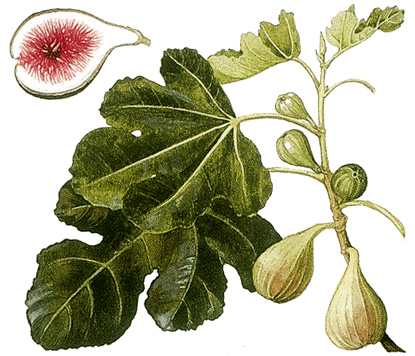Fig is a fruit that has been cultivated for more than 10,000 years. It originated in the Mediterranean region. Ancient Greek, Roman, and Egyptian documents describe its popularity as a food. Figs are small and round or pear-shaped. They have green, yellow, pink, purple, brown, or black skins, depending on the variety. They have a high sugar content. People eat them fresh, dried, canned, or preserved in sugar.
Figs grow on trees of the same name. Fig trees thrive in climates with hot, dry summers and cool, moist winters. The most important fig-producing countries are Egypt and Turkey. Other major fig-growing countries include Algeria, Iran, Morocco, and Syria. California produces most of the figs grown in the United States.

Most fig trees grow to less than 33 feet (10 meters) tall and have a trunk about 3 1/4 feet (1 meter) in diameter. The trees have deeply lobed leaves. The fruit develops from podlike structures that grow on the branches. These structures contain hundreds of tiny flowers. As the fruits develop, the podlike structures enlarge and become fleshy. Fig trees bear two or three crops of fruit each year.
There are four main types of figs: (1) caprifigs, (2) Smyrna figs, (3) common figs, and (4) San Pedro figs. The wild caprifig trees seldom produce edible fruit. Small fig wasps live inside the caprifigs. When the wasps leave the figs, they carry pollen from the flowers. The Smyrna fig depends on these pollen-carrying wasps to pollinate its flowers. All varieties of Smyrna figs require pollen from caprifigs to bear fruit. The common fig does not require pollination to produce fruit. The San Pedro fig produces two types of fig crops each year. The first crop, harvested in early summer, develops without pollination, like the common fig. The second crop, which matures in late summer, must be pollinated by the fig wasp, like the Smyrna fig.
Growers produce new fig trees from branches cut from other fig trees. In most cases, the new trees bear fruit two to four years later. Mediterranean fruit flies and tiny worms called nematodes are among the fig tree’s most troublesome pests.
Ripe figs spoil easily and cannot be shipped long distances to market. For this reason, most growers dry their crop—either in the sun or in ovens—before shipping.
